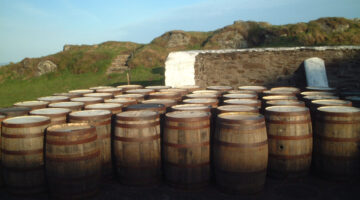What is Sake?
Travel Distilled explains what the Japanese drink sake is, its history, how it’s made, its serving rituals, cultural significance, and more.

Sake is a rice wine, deeply ingrained in Japanese culture. It transcends its liquid form to embody the essence of craftsmanship, ritual, and a connection to nature. As you delve into the world of sake, you discover a drink with a rich history, a complex production process, and a profound impact on Japanese society and beyond.
What is Sake’s History?
The roots of sake reach back over a millennium, intertwining with the cultural and religious tapestry of Japan. Its origins are often traced to the Nara period (710-794), where the earliest records of rice cultivation and brewing techniques emerged. Initially reserved for religious ceremonies, sake gradually found its way into the social fabric of Japanese society, becoming an integral part of celebrations, rituals, and everyday life.

The Art of Brewing Sake
The craftsmanship involved in brewing sake is a meticulous dance that harmonizes tradition and modernity. Sake production revolves around polished rice, water, yeast, and a unique mold called koji-kin. The rice, often a special sake rice variety, is polished to remove the outer layers, leaving behind the starchy core. This polishing process is a critical factor in determining the quality and style of the final sake.
After polishing, the rice undergoes a complex fermentation process. Koji-kin mold is sprinkled over the rice, initiating the conversion of starches into fermentable sugars. Yeast is then introduced to the mixture, triggering the fermentation that transforms sugars into alcohol. The result is a liquid that ranges from sweet to dry, with a myriad of flavor profiles depending on the brewing methods and ingredients.

Types and Styles
Sake is categorized based on various factors, including the degree of rice polishing, brewing methods, and the addition of distilled alcohol. Junmai, Honjozo, Ginjo, and Daiginjo are some of the classifications, each offering a unique taste experience. Junmai sake, for instance, is made with only rice, water, yeast, and koji-kin, while Ginjo and Daiginjo involve higher levels of rice polishing, resulting in a more refined and fragrant profile.
Beyond these classifications, there are sparkling sakes, aged sakes, and regional variations that showcase the diversity within the sake universe. Each type carries its own charm, inviting enthusiasts to explore the vast spectrum of flavors and textures.

Cultural Significance
Sake is deeply woven into the fabric of Japanese culture, serving as an integral part of religious ceremonies, weddings, and festivals. The “kagami biraki,” a ritual of breaking open a sake barrel with wooden mallets, is a symbol of celebration and shared joy. Sake is also offered at Shinto shrines as a gesture of gratitude and connection to the divine.
The concept of “itadakimasu,” a phrase uttered before meals, carries a profound meaning of expressing gratitude for the sustenance about to be received. Sake often accompanies these moments, fostering a sense of togetherness and appreciation for life’s simple pleasures.
The Role of Nature
Sake brewing is not just a science; it is a dance with nature. The quality of water, the climate of the region, and the dedication of brewers all contribute to the final product. Many sake breweries are nestled in picturesque landscapes with pristine water sources, reflecting a deep respect for the natural elements that shape the drink.
Serving Rituals
 The Japanese have developed a unique and intricate set of rituals for serving and consuming sake. From the traditional “ochoko” (small cups) to the more modern wine glasses, the vessel used can influence the drinking experience. Temperature also plays a crucial role; sake can be served chilled, at room temperature, or warmed, with each method accentuating different aspects of its flavor profile.
The Japanese have developed a unique and intricate set of rituals for serving and consuming sake. From the traditional “ochoko” (small cups) to the more modern wine glasses, the vessel used can influence the drinking experience. Temperature also plays a crucial role; sake can be served chilled, at room temperature, or warmed, with each method accentuating different aspects of its flavor profile.
What is Sake’s Global Impact
While sake has been a cornerstone of Japanese culture for centuries, its influence has spread far beyond the shores of Japan. Internationally, sake has gained recognition as a sophisticated and versatile beverage. Sake bars and restaurants dedicated to showcasing the diversity of Japanese rice wine have become increasingly popular in major cities worldwide.
Challenges and Innovations
Despite its rich heritage, the sake industry has faced challenges in recent years. Changing demographics, competition from other beverages, and a decline in sake consumption within Japan have prompted the industry to adapt. Some breweries are embracing innovation by experimenting with new flavors, brewing techniques, and marketing strategies to appeal to a broader audience.
Sake in the Culinary World
Beyond being a standalone beverage, sake has found a place in the culinary world. It complements a wide range of dishes, from sushi and sashimi to more complex and flavorful cuisines. The delicate balance of acidity, sweetness, and umami in sake makes it a versatile companion for diverse culinary experiences.

Conclusion
In conclusion, sake is more than a drink; it is a cultural touchstone that reflects Japan’s history, spirituality, and reverence for nature. The artistry of sake brewing, the rituals surrounding its consumption, and its role in fostering communal bonds make it a symbol of Japanese identity. As sake continues to transcend borders, it invites enthusiasts to embark on a journey that explores not only the flavors within the glass but also the rich tapestry of a nation’s heritage.











